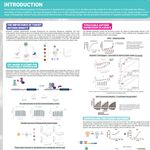POSTER: Rapid Biuret Based Colorimetric Assay for Protein Quantification
Protein quantitation assays are essential for workflows that include protein extraction, labeling, and analysis. The simplest method for protein quantitation is measuring the absorbance of a protein sample at 280 nm (A280) and calculating the quantity using the Beer Lambert Law. However, this method is only applicable when the sample is a purified protein solution. Most cell biology experiments result in mixed or unpurified protein samples extracted from cell or tissue lysates. The Bradford assay (or Coomassie dye–based assay) has been a standard protein quantitation assay for unpurified proteins for some time, but a major drawback of this assay is its poor linearity. An improved assay, the Thermo Scientific™ Pierce™ BCA Protein Assay using bicinchoninic acid, is a chelator-based assay with exceptional linearity and low protein-to-protein variability that was quickly established as the “gold standard” for protein assays. One drawback with this assay, though, is the relatively long incubation time (30 minutes at 37˚C or 2 hours at room temperature). This poster presents the development of an improved BCA protein quantitation assay, the new Thermo Scientific™ Pierce™ Rapid Gold BCA Protein Assay, that addresses the need for a shorter incubation time (5 minutes at room temperature). Herein we present our evaluation of protein-to-protein variability, accuracy of “known” protein mixes, and closeness in protein estimation for this new assay as compared to the classic BCA assay. The results of this evaluation demonstrate that the new Pierce Rapid Gold BCA assay with the shorter incubation time provides the same accuracy as the original BCA assay.
Learning Objectives:
- A rapid way to quantitate protein using the same principle as the traditional BCA assay




